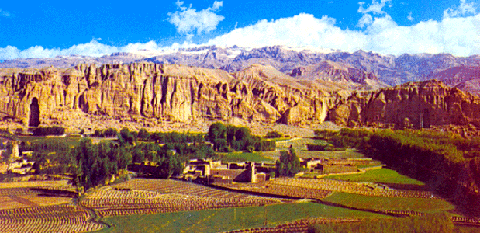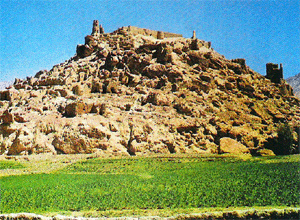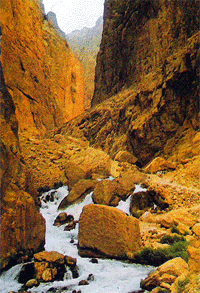Bamiyan with  its archeological remains is the most conspicuous tourist sit of Afghanistan. The village lies about 2500m above sea level, 240 km west of Kabul attracts thousand of visitors annually. The exquisite beauty of this valley is embraced by the snow capped range ofthe Kohe Baba Mountains in the south and in the north by the steep cliffs in which massive images of Buddha are carved. The pastel colors of its surroundings give visitors an impression of the magnificence and serenity of nature. The area of Bamiyan developed under Kanishka the great to become a major commercial and religious center and the smaller statue of Buddha (38 m high) was builtduring his reign. Two centuries later the colossal Buddha statue (55m high) was carved. Thousands of ornamented caves, from the entire Buddhist world poured into Bamiyan to admire its spectacular and sacred sites. Bamiyan fell to the Islamic conquerors in the 9th century. its archeological remains is the most conspicuous tourist sit of Afghanistan. The village lies about 2500m above sea level, 240 km west of Kabul attracts thousand of visitors annually. The exquisite beauty of this valley is embraced by the snow capped range ofthe Kohe Baba Mountains in the south and in the north by the steep cliffs in which massive images of Buddha are carved. The pastel colors of its surroundings give visitors an impression of the magnificence and serenity of nature. The area of Bamiyan developed under Kanishka the great to become a major commercial and religious center and the smaller statue of Buddha (38 m high) was builtduring his reign. Two centuries later the colossal Buddha statue (55m high) was carved. Thousands of ornamented caves, from the entire Buddhist world poured into Bamiyan to admire its spectacular and sacred sites. Bamiyan fell to the Islamic conquerors in the 9th century.

SHAHRE GHOLGHOLA: The Islamic city of Bamiyan was destroyed by GenghisK han in 1221 in revenge of the death of his grandson Mutugen. The ruins of the citadel called city of noise, still give evidence of its magnitude before Mongol devastation. han in 1221 in revenge of the death of his grandson Mutugen. The ruins of the citadel called city of noise, still give evidence of its magnitude before Mongol devastation.
 SHAHRE ZOHAK: This mass of ruins was once a principle fortress, protecting the entrance to the city of Bamiyan during the reigns of the Shansabani Kings in the 12th and 13th century. It also fell victim to Genghis Khan's vengeance. SHAHRE ZOHAK: This mass of ruins was once a principle fortress, protecting the entrance to the city of Bamiyan during the reigns of the Shansabani Kings in the 12th and 13th century. It also fell victim to Genghis Khan's vengeance.
 AJARY VALLEY: This beautiful lush green valley embracedby picturesque mountains of fascinating formations and glooming ever colors, with a sparkling clear stream, full of trout leading in into a breathing chasm, is an unforgettable for every visitor. AJARY VALLEY: This beautiful lush green valley embracedby picturesque mountains of fascinating formations and glooming ever colors, with a sparkling clear stream, full of trout leading in into a breathing chasm, is an unforgettable for every visitor.
|